
Ecommerce insights on the go
Tune in to the Make it Big Podcast — our thought leadership audio series for retailers, entrepreneurs and ecommerce professionals. You'll get expert insights, strategies and tactics to help grow your business.

2022 Global Ecommerce Report: Fashion and Apparel
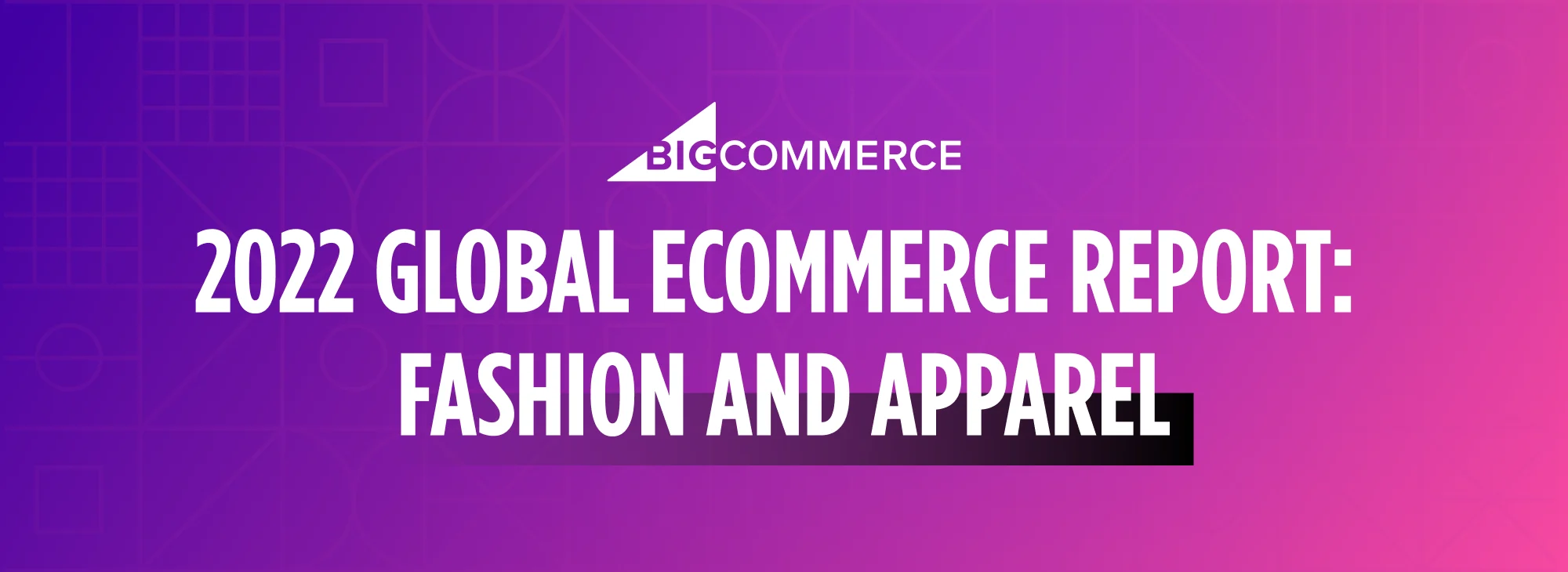

2022 Global Ecommerce Report: Fashion and Apparel
Get The Print Version
Tired of scrolling? Download a PDF version for easier offline reading and sharing with coworkers.
A link to download the PDF will arrive in your inbox shortly.
Technological advances, a fading pandemic and returning confidence in the supply chain stand to make 2022 a banner year for ecommerce.
Based on growth projections, retail ecommerce sales will surpass $1 trillion for the first time ever in 2022, according to eMarketer’s US Ecommerce by Category 2022 report. And while inflation concerns would seem to contradict this, consumers spent $2.8 billion in added cost from January to March, according to Adobe Analytics.
With an expectation that ecommerce growth will return to pre-pandemic levels this year, knowing what to expect and where to invest in 2022 carries outsized importance.
For BigCommerce’s first industry trend report, we examine the fashion category as it emerges from the other side of two years impacted by the COVID-19 pandemic. Despite widespread staffing shortages and supply chain issues, the fashion and apparel industry saw $180.5 billion in ecommerce revenue in 2021, up from $145 billion in 2020.
Relative to all other industries in global ecommerce, fashion sits middle-of-the-road in terms of projected growth for 2022. Growth estimates place ecommerce revenue in 2022 at roughly $205 billion.
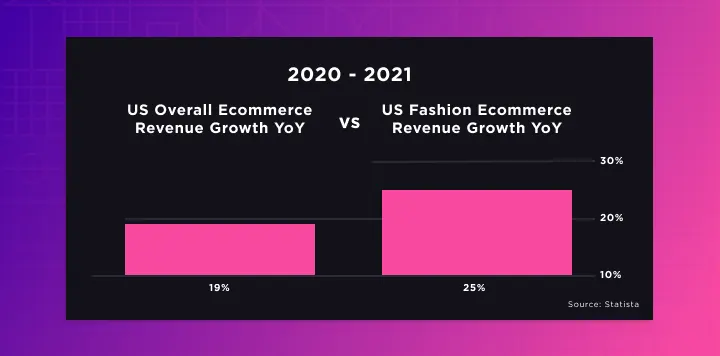
Against this backdrop, the fashion industry kept pace with these projections in the first three months of the year.
Read our full report for more insights into the state of fashion ecommerce so far in 2022 from BigCommerce and our merchants.
Methodology
BigCommerce’s fashion data is sourced directly from our customers. All data is global and pertains to all countries where BigCommerce merchants do business, unless otherwise noted.
All comparisons quarter-over-quarter and year-over-year are congruent comparisons between the same number of existing stores dating back to the earliest period used in the comparison. For example, a comparison between Q1 2021 and Q1 2022 would use data only from BigCommerce stores that existed in Q1 2021, unless otherwise noted.
For mentions of visitor sources in Q1 2022, this data excludes January 2022 and should be regarded directionally.
For verbatim insights from our customers, we posed a survey in our customer control panel consisting of four questions about fashion industry technology trends and tactics.
How the Fashion Industry Performed in Q1 2022
We said 2022 would be a banner year for ecommerce and that goes doubly so for the fashion industry.
So far in Q1 2022, we can see a 3% increase in inclusive GMV for ecommerce as a whole compared to Q1 2021. Fashion and apparel, however, has grown 19% by the same measure.
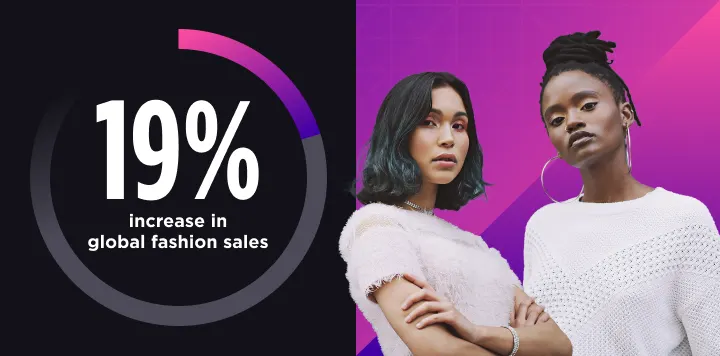
The same outperformance of the ecommerce landscape holds true for fashion’s average order volume. While average order volume (AOV) grew 3% between Q1 2021 and Q1 2022 for all ecommerce industries, fashion saw a 13% increase in AOV comparing the same two periods.
While less pronounced, the trend continues to the total number of orders as well. Order totals across all BigCommerce were flat quarter-over-quarter (QoQ), but fashion stores saw a 5% increase in number of orders between Q1 2021 and Q1 2022.
The top channels for fashion continued their dominance.
The first quarter of this year was huge for sales through Amazon for BigCommerce fashion merchants. Compared to last year, there was a 321% increase in inclusive GMV and a 276% increase in orders.
Meanwhile BigCommerce fashion merchants selling through eBay overcame a downward trend for GMV and AOV in Q1 of -12% and -14%, respectively. The fashion and apparel category saw a complete reversal of this trend on eBay with a gain of 29% GMV and 44% AOV in Q1 2022.
We saw shifts in sales by mobile device.
Strangely, despite the growing trends towards social commerce, Q1 2022 saw a decline in the number of orders placed with a mobile device compared to all ecommerce retail in Q1 2021. There was a decline of 4%.
However, even with this decline in total orders we saw a slight increase in GMV by 2%.
The fashion industry was counter to this trend, with a 13% QoQ increase in GMV by mobile device and average order value also jumped 14%.
BigCommerce funded a consumer survey by Profitwell of over 4,000 online shoppers over the age of 18. Of those shoppers, 80% said they purchase apparel and clothing using phone apps or web browsers.
Fashion came out as the top category for the question out of 15 categories, with the next highest response being 56% for electronics purchases.
North America fashion outpaced overall North America ecommerce.
Ecommerce growth was modest for North America in the first quarter of the year at 2% GMV QoQ, a decrease in orders of 1% QoQ and AOV moving up 3% QoQ.
The fashion industry, however, blew those numbers away. Fashion GMV was up 24% in Q1 2022 versus Q1 2021. Total number of orders went up 13% QoQ and AOV was up similarly at 13%.
Fashion in APAC saw growth; EMEA major decline.
Overall ecommerce retail in APAC saw major growth QoQ in Q1 2022 with an 19% increase in GMV and a 17% increase in orders. Fashion didn’t exactly keep pace with that in APAC and only saw a QoQ increase in GMV of 11% and a 9% increase in AOV. Total number of orders was flat.
Stagnation hit EMEA ecommerce in Q1. There was only a 3% QoQ increase in Q1 GMV and 8% QoQ increase in Q1 AOV. Fashion in EMEA appears to have suffered from this overall trend and contracted considerably. GMV was down 15% QoQ in Q1 and total orders were down 27% QoQ.
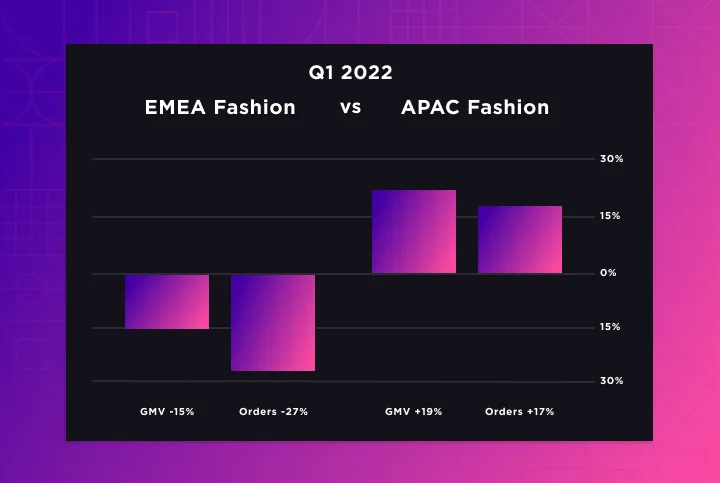
Fashion and Apparel Ecommerce Trends in 2022
It should come as no surprise that the fashion and apparel industry is regarded as a trendsetter, both on the runway and online.
As we look back on Q1, here are some notable ecommerce trends shaping this dynamic category:
Social commerce has become a priority.
The evolution has been gradual but apparent to anyone who spends time on social media. The friction in buying and selling through channels like Instagram and TikTok is all but gone.
In a survey posed to BigCommerce merchants, 48% of respondents cited social media or social commerce as the shopping trend or technology with the greatest impact to their overall business in 2021.
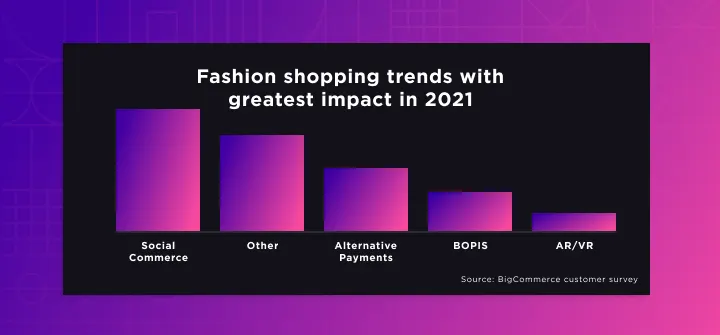
When posed the same question, but specific to the fashion and apparel industry, social commerce remained the top response.
BigCommerce merchant, Crutcher’s Western Wear, added, “Being able to offer checkout on Instagram and Facebook had the biggest impact on our 2021 business.”
We can expect this trend to grow as more fashion merchants chase it. A later question in the survey asked what new tactics merchants would implement in 2022, with respondents most frequently pointing to social commerce.
BigCommerce merchant data corroborates this trend. For fashion merchants selling through Instagram we saw a 741% increase in total number of orders comparing Q1 2022 with Q1 2021.
What’s next for social commerce? Sellers and buyers alike are already benefiting from the emerging live shopping trend. If you want to streamline product discovery and purchases, look no further than Instagram, Facebook and TikTok.
Closing the sale means offering more payment options.
The next most common response to our survey question regarding the greatest impact to overall business in 2021 — excluding uncategorized responses — was “offering alternative payment methods.”
This would include offering Buy Now, Pay Later (BNPL) and acceptance of cryptocurrency and digital wallets. 25% of survey respondents said offering flexibility in payments proved most impactful to their businesses.
Eight percent of respondents said that Buy Online, Pickup In-store (BOPIS) was the greatest factor in improving their businesses in 2021.
The takeaway is clear: Giving potential buyers options yields positive results for ecommerce retail sales.
A connected customer experience remains key.
We can all agree on the importance of customer experience. But just how impactful is customer experience in 2022?
In our merchant survey, 44% of respondents prioritized enhancing their customers’ experience through omnichannel presence, improved customer service and shipping, while 20% pointed to omnichannel selling specifically.
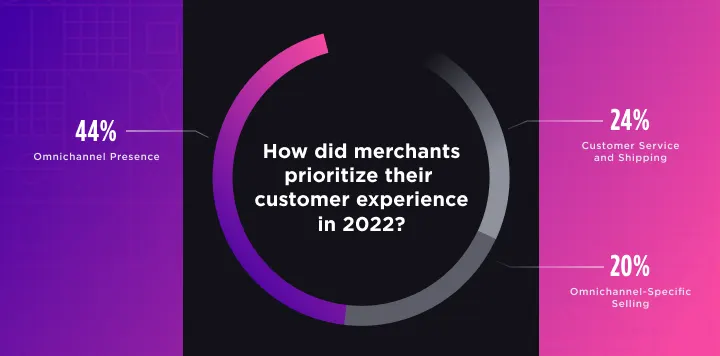
Our survey surfaced some miscellaneous callouts.
While not as prevalent as the trends highlighted above, some verbatim responses to our survey showed interest in other areas of ecommerce technology and tactics.
Interest in omnichannel selling, optimizing the returns process, SEO, SMS, checkout optimization and personalization was voiced in open responses to questions about technologies making the most impact and ways merchants are planning to enhance customer experience in 2022.
Mainstays of the ecommerce marketing arsenal like email newsletters and content marketing warranted passing mentions in the survey.
The Future of Fashion and Apparel Ecommerce is Now
The fashion industry stands to benefit most from adopting emerging technologies. The challenges of matching customers to the right product from the comfort of their own home and offering frictionless checkout experiences are now largely met.
Some areas that are ripe for getting ahead of the curve are user experience (UX), augmented reality (AR), MetaVerse retail experiences and artificial intelligence (AI).
Optimize the user experience.
Responsiveness to the way customers are interacting with fashion shops is key to growing and remaining competitive.
BigCommerce spoke with fashion brand Natori about the importance of staying the course on the front-end journey if you hope to arrive at the right user experience. They cited their collaboration with BigCommerce partner Groove Commerce in their success.
Natori’s president, Kenneth Natori, gave his insight on the importance of that front-end experience.
“Our website is a critical component of how our customers discover and experience the Natori family of brands and products. The team at Groove was crucial in helping us design an elevated user experience that will help us digitally connect with consumers. We are very proud to showcase the widest assortment of Natori designed product anywhere in the world.”
Arriving here required striking a balance between form and function. Ethan Giffin, founder and CEO of Groove explained, “For a brand like Natori, site design and functionality carry equal weight. Our goal was to bring their brand to life by creating a shopping experience that effectively combines merchandising best practices with Natori’s unique story.
“The new website immerses the shopper in an aesthetically indulgent experience while still allowing for natural discovery and faster browsing.”
The flexibility of headless commerce.
Part of offering a strong user experience is staying agile. Headless commerce, or the decoupling of a store’s frontend design from its ecommerce backend, affords a merchant exactly that.
Mark Howes, Vice President of Sales for EMEA at BigCommerce explains it this way.
“Traditional systems have worked well for years now, but the tech and the customer landscape has evolved rapidly. Businesses need to take a new approach to content management. This is where headless comes in.
“Headless commerce is focused on being able to evolve your offering at speed and give customers the opportunity to interact with your brand in the ways that they choose.”
If there were any doubt where a fashion brand’s priorities should be when it comes to providing a flexible user experience, Howes dispels it:
“Front-end freedom is what this is all about.”
Augment the shopping experience.
The augmented reality market is estimated to reach $78 billion by 2028. A large driver of this predicted growth is the adoption of AR by both online and brick-and-mortar retailers to improve upon the shopping experience.
Visualizing various styles and colors of a garment or accessory without actually manually swapping them out used to be the stuff of science fiction, but it will now define the ecommerce retail experience for the discerning consumer.
Similarly, being able to interact with three-dimensionally rendered high-definition representations of products in real-time will give shoppers confidence in pulling the trigger on purchases of products that are currently still met with hesitation.
We feel we should examine craftsmanship and spatial attributes in person. Now we will be able to do this from our mobile devices and AR headsets.
BigCommerce interviewed augmented reality product configurator ThreeKit’s VP of Marketing and Alliances, Marc Uible, for the Make It Big Podcast to hear an expert perspective on how and why fashion merchants should adopt this trend. Uribe had this advice:
“We encourage people to start. Start with one product. Experience it. You will see an ROI because people love this experience…Shoppers love to engage…and then you can expand. We haven’t had a single customer in two years attrit because they’re saying, ‘This isn’t working.’ So we haven’t lost a single customer saying, ‘Oh, the people just aren’t engaging, they don’t like it.’”
Enter the MetaVerse.
You have surely heard of the MetaVerse — the virtual reality network for real-time social and retail experiences that has dominated technology news cycles for the last year. Then, you must be aware that the MetaVerse promises to change our very existence forever by marrying our insatiable hunger for information with the ability to experience it in a tactile, immersive way.
What you may not know is that fashion brands like Hermes and Gucci have already invested in non-fungible tokens (NFTs) to generate interest in the MetaVerse retail future.
Consumers’ interest in shopping in the MetaVerse exists already. Referring back to our consumer survey with Profitwell, 46% of those online shoppers responded that they would be willing to shop in the MetaVerse based on their current understanding of the technology. Somewhat encouraging to retailers planning on capitalizing on the MetaVerse, 2% of online shoppers responded that they already have shopped in the MetaVerse.
Of interest to online retailers: Those most willing to make purchases in the MetaVerse skewed mostly in the Gen Z and Millennial demographics and had a positively correlated interest relative to their income.
Solve customer pain points with AI.
BigCommerce has seen this trend for some time. There are a number of ways that artificial intelligence can impact ecommerce. The majority of them result in optimized and automated workflows for the merchant and seamless experiences for the customer.
For example, online retailers seeking ways to curb returns have begun implementing artificial intelligence solutions to stop that bleeding from their bottom lines.
For fashion merchants interested in using AI in 2022, our partner Bloomreach developed a comprehensive How-To Guide.
Looking Ahead to the Second Half of 2022
If the trends of the first quarter of 2022 stay constant or improve for the fashion industry, we can expect that the fashion category will outpace ecommerce retail overall, but see a year that is in the middle of the pack compared to all other verticals.
In a year projected to top $1 trillion in sales, that’s encouraging, if not exciting.
BigCommerce Senior Vice President of Product Marketing Meghan Stabler sees a continuation of the technology trends outlined above.
“To really stand out from the crowd and stay relevant, that means staying on top of the latest capabilities and remaining agile. Frankly, the new trends — AR, artificial intelligence — will eventually become the old trends as more retailers adopt them to attract and convert shoppers where they are. Ecommerce is as competitive as ever. What is your differentiator going to be?”
The ecommerce landscape is constantly evolving and could see yet more trends emerge before the year is out.
The Final Word
Taking stock of our data and the sentiment of those in the industry, we can confidently say that fashion and apparel merchants are taking well to the trends that are sweeping ecommerce retail.
We see the fashion category outpacing overall growth for ecommerce in 2022, with the potential for a record-setting year.
Additionally, the fashion and apparel industry is uniquely positioned to capitalize on emerging technology and consumer trends.
Social commerce remains a definitive focal point for the industry as well as omnichannel presence. Customer experience and payment type flexibility round out the consumer needs of Q1 2022.
Looking ahead, we see AI, AR and MetaVerse retail experiences looming as the next challenges for merchants looking to stay ahead of the curve.
Be sure to read our next 2022 Ecommerce Forecast in Q3 when we’ll take a look at the sports and outdoors category heading into the holiday season.

Pablo Gallaga is a Senior Manager of Content Marketing at BigCommerce where he focuses on thought leadership content. His years of experience in tech, from startups to enterprise, inform his ecommerce insights.


